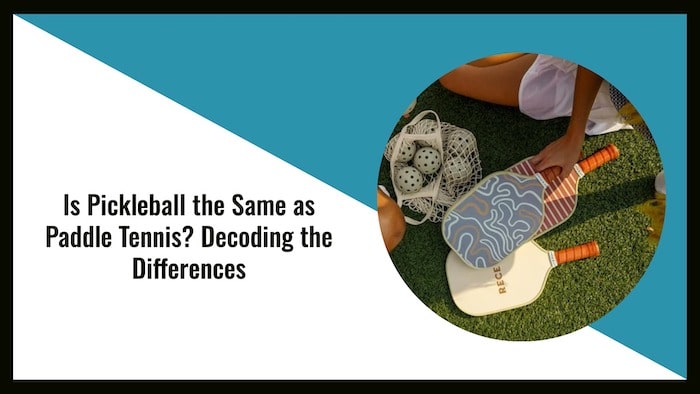Welcome to our blog, where we dive into the world of racket sports and explore the question on many enthusiasts’ minds: “Is Pickleball the Same as Paddle Tennis?” These two sports have gained popularity in recent years, but are often confused due to their similarities in equipment and gameplay.
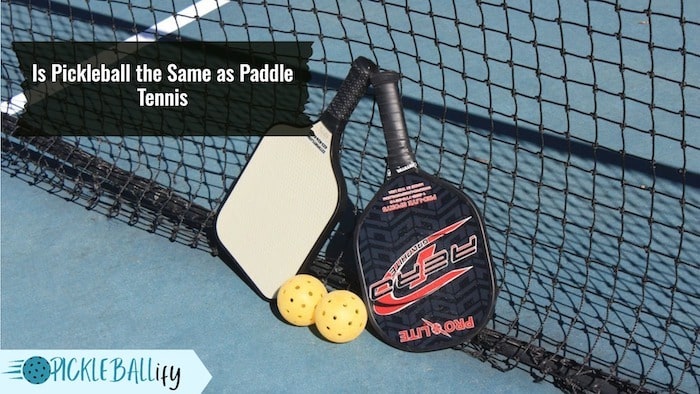
In this article, we will compare and contrast the key aspects of Pickleball and Paddle Tennis, shedding light on their similarities and differences to help you better understand these two unique sports.
Whether you’re a seasoned player or a curious newbie, read on to discover the nuances between Pickleball and Paddle Tennis and gain a clearer understanding of how they differ from each other. Let’s settle the score once and for all!
What Is Pickleball and How Is It Played?
Pickleball is a sport that combines elements of tennis, badminton, and table tennis. It was invented in 1965 on Bainbridge Island, Washington, by three dads who wanted to create a fun game for their kids. Since then, pickleball has grown in popularity and is now played in over 45 countries and 5 continents.
Pickleball is played on a court that is 20 feet by 44 feet, which is the same size as a doubles badminton court. The net is 36 inches high at the sidelines and 34 inches high in the middle. The ball is a perforated plastic ball that is similar to a wiffle ball. The paddle is a solid-faced paddle that can be made of wood or composite materials.
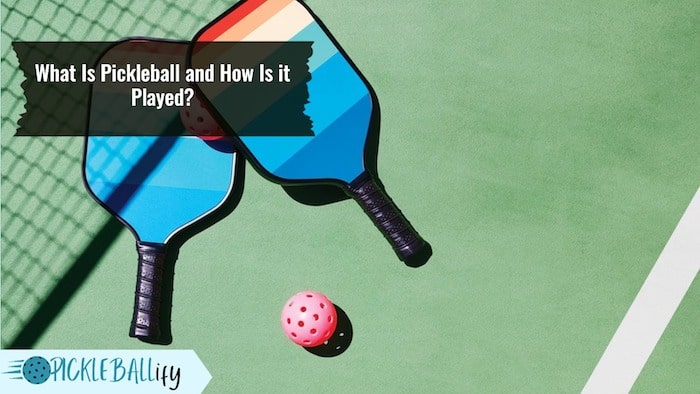
Pickleball can be played indoors or outdoors, in singles or doubles. The rules are simple and easy to learn. The serve is underhand and must land in the diagonal service court. The ball must bounce once before being hit by the receiver.
The players must also let the ball bounce once before hitting it in the non-volley zone, which is a 7-foot area on both sides of the net. This zone is also known as the “kitchen”. The rally continues until one side commits a fault, such as hitting the ball out of bounds, into the net, or into the non-volley zone without letting it bounce first.
The scoring system is similar to tennis, except that only the serving side can score points. The game is played until one side reaches 11 points, with a two-point margin.
What Is Paddle Tennis and How Is it Different From Pickleball?
Another activity that has been modified from tennis and is played on a smaller court is paddle tennis. Frank Peter Beal, an Episcopal pastor who intended to develop a kid-friendly pastime, created it in 1898 in Albion, Michigan. Murray Geller went on to popularise it in New York City, making minor adjustments to the game’s equipment and regulations to make it more interesting to adults.
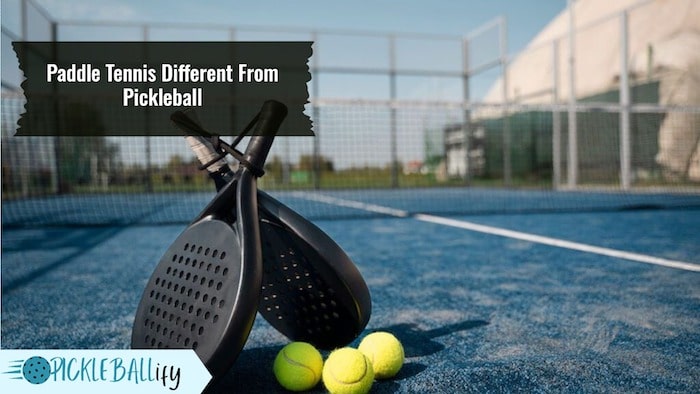
A court that is somewhat bigger than a pickleball court, measuring 50 feet by 20 feet, is used for paddle tennis. The height of the net is 33 inches at the posts and 31 inches at the middle. The object is a tennis ball that has been depressurized and has less bounce than a standard tennis ball. While it resembles a pickleball paddle, the paddle has holes in it.
Paddle tennis may be played solo or with a partner outside or inside. The serve must land in the service box and is sloppily delivered. The ball can be struck immediately or after one bounce (volley). If the ball bounces once before hitting them, the players may also use the surrounding walls or fences to keep the ball in play.
Games are scored using a four-point system (15-30-40-game) similar to tennis, and sets are made up of six games (with a tie-breaker at 6-6). The match may be a best of three or best of five.
Similarities and Differences Between Pickleball and Paddle Tennis
As we have seen, pickleball and paddle tennis have some common features that make them both enjoyable racket sports for people of all ages and abilities. They both require less space than tennis, less power than squash, and more strategy than table tennis. They both offer a great workout for the body and mind, as well as an opportunity for social interaction and fun.
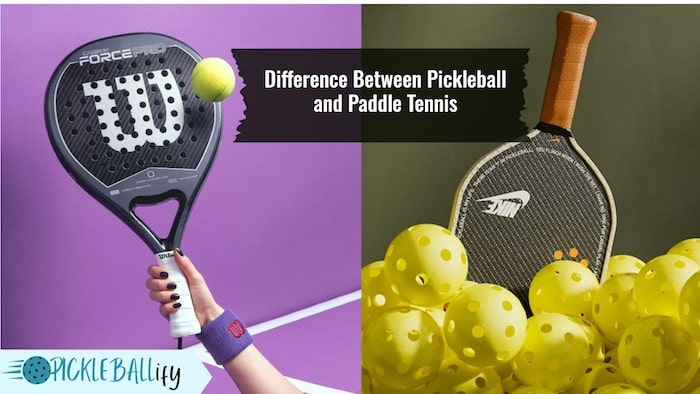
However, there are also some significant differences between pickleball and paddle tennis that make them distinct sports with different challenges and skills. Here are some of them:
Court Size and Layout
One of the main differences between pickleball and paddle tennis is the size and layout of the court. A pickleball court is 44 feet long and 20 feet wide, with a net height of 34 inches at the center and 36 inches at the sides. A paddle tennis court is 50 feet long and 20 feet wide, with a net height of 31 inches at the center.
Another difference is that pickleball has a non-volley zone (also known as the kitchen) that extends 7 feet from the net on both sides. This is an area where players cannot hit the ball in the air (volley) before it bounces on the ground.
The simplest way is to just lower the tennis net to 34″ in the center. Lines may be taped or painted on the court for pickleball (always check with facility first). Then the court can be used for both tennis and pickleball very easily. Stated in USAPickleball.
This prevents players from smashing the ball at close range and adds more strategy to the game. Paddle tennis does not have a non-volley zone, but it has a backcourt that extends 10 feet from the baseline on both sides. This is an area where players can return balls that bounce off the screens that surround the court.
Equipment: Paddles and Balls
Another difference between pickleball and paddle tennis is the equipment used. Pickleball paddles are usually made of wood, composite, or graphite, and they have a smooth surface.
They are typically 8 inches wide and 15 inches long, with a maximum weight of 17 ounces. Pickleball balls are made of hard plastic with holes in them, similar to wiffle balls. They are about 3 inches in diameter and weigh about 0.9 ounces.
Paddle tennis paddles are usually made of wood or fiberglass, and they can have a smooth or textured surface. They can also have air holes with a diameter no greater than 3/8 inch.
They are typically 9.5 inches wide and 18 inches long, with a maximum weight of 14 ounces. Paddle tennis balls are made of solid rubber with no holes in them. They are about 2.5 inches in diameter and weigh about 1.9 ounces.
Scoring Rules and Style of Serve
Another difference between pickleball and paddle tennis is the scoring rules and style of serve. Pickleball uses a simple scoring system where each game is played to 11 points, with a win by two rule.
Only the serving team can score points, and each team has two serves per turn (one for each player in doubles). The serve must be underhand, diagonal, and clear the non-volley zone.
Paddle tennis uses the same scoring system as tennis, where each game is played to four points (love-15-30-40-game), each set is played to six games (with a tie-breaker at 6-6), and each match is played to best of three sets. Both teams can score points on any rally, and each player has one serve
Benefits of Playing Pickleball and Paddle Tennis
Playing pickleball and paddle tennis has several benefits for your physical and mental health, as well as your social well-being. Here are some of them:
- Physical exercise: These games include moving around, striking the ball, and changing directions, which gives your body a great workout. They can aid in calorie burning, muscular building, balance improvement, and flexibility growth. Also, they can lower the chance of developing chronic illnesses including diabetes, heart disease, and stroke.
- Hand-eye coordination: You must coordinate your eyes and hands in both sports to strike the ball properly and tactically. Your response time, spatial awareness, and fine motor abilities can all be enhanced by doing this. Also, it can improve your cognitive skills including memory, focus, and problem-solving.
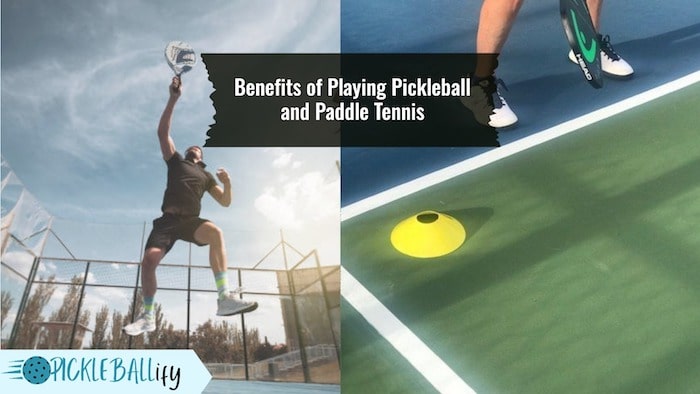
- Cardiovascular endurance: Both sports can enhance your cardiovascular endurance, or your heart’s and lungs’ capacity to provide your muscles with oxygen and nutrients for a sustained period of physical exercise. Your endurance, vitality, and general fitness may all be improved by doing this. Moreover, it can reduce your cholesterol, blood pressure, and resting heart rate.
- Stress relief: You may reduce stress and boost your mood by participating in any sport. They may provide you a sense of accomplishment, a constructive outlet for your emotions, and a break from your troubles. Endorphins, which are organic compounds that make you feel content and calm, can also be stimulated by them.
- Social interaction: Both sports are social activities that let you socialise and make new acquaintances. People of all ages, backgrounds, and skill levels are available to play with. In addition, you can have fun, laugh a lot, and feel a sense of togetherness. Playing with other people might inspire you to get better at it and have more fun.
How to Choose Between Pickleball and Paddle Tennis
If you are trying to decide between pickleball and paddle tennis, the best advice is to try both games and see which one you enjoy more. Both sports are easy to learn, and you can quickly pick up the basics. However, they also have some differences that may suit your preferences and abilities better.
Here are some factors to consider when choosing between pickleball and paddle tennis:
1) Skill level: If you are a beginner or have limited mobility, you may find pickleball easier to play than paddle tennis. Pickleball has a smaller court, a lower net, and a lighter ball that moves slower than a paddle tennis ball. This means you don’t have to run as much, hit as hard, or react as fast. Pickleball also has a simpler scoring system and fewer rules to remember.
However, if you are an advanced player or have more experience with tennis or racquet sports, you may find paddle tennis more challenging and rewarding than pickleball. Paddle tennis has a larger court, a higher net, and a heavier ball that moves faster than a pickleball ball.
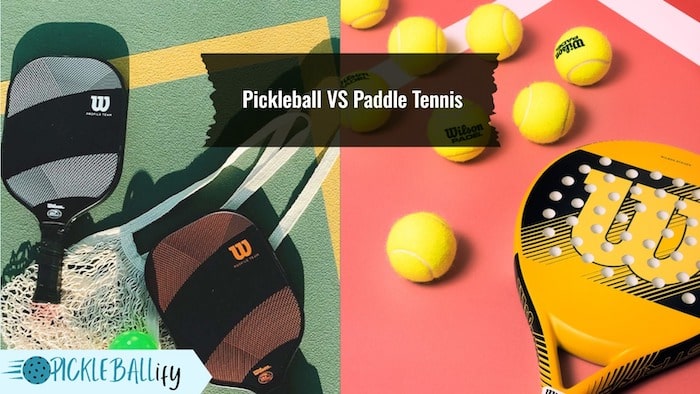
This means you have to cover more ground, hit with more power and spin, and react with more agility. Paddle tennis also has more complex scoring and rules that add more strategy and variety to the game.
2) Availability: Another factor to consider is the availability of courts, equipment, and players in your area. Depending on where you live, you may have more or less access to pickleball or paddle tennis facilities and communities.
You can check online or ask around to find out where you can play these sports near you. You can also join local clubs or leagues, or sign up for tournaments or events. You may also want to consider the cost of playing these sports, such as court fees, membership fees, equipment costs, etc.
3) Preference: Ultimately, the most important factor is your personal preference. You should choose the sport that you enjoy the most and that suits your goals and style. You may like pickleball for its simplicity, accessibility, and fun factor.
You may like paddle tennis for its intensity, complexity, and skill factor. Or you may like both sports for different reasons and occasions. There is no right or wrong answer here; it’s up to you to decide what makes you happy.
FAQs
While both sports share similarities in terms of equipment and gameplay, there are notable differences between Pickleball and Paddle Tennis. Pickleball is played on a smaller court with a solid paddle and a plastic ball, while Paddle Tennis is played on a larger court with a solid paddle and a rubber ball. Additionally, the rules and scoring systems of the two sports also have distinct variations.
While Pickleball and Paddle Tennis both use solid paddles, they have different specifications. Pickleball paddles are typically lighter and have perforated holes on the surface, while Paddle Tennis paddles are heavier and do not have holes. Additionally, Pickleball uses a plastic ball, while Paddle Tennis uses a rubber ball. Therefore, it’s important to use the appropriate equipment for each sport to ensure fair gameplay and adhere to the rules.
Yes, both Pickleball and Paddle Tennis can be played both indoors and outdoors. While they are traditionally played on outdoor courts, indoor facilities with specialized courts are also available in many areas. Indoor play can offer the advantage of playing year-round regardless of weather conditions, while outdoor play allows players to enjoy the fresh air and natural surroundings. Both indoor and outdoor settings have their unique characteristics and offer different playing experiences.
Yes, both Pickleball and Paddle Tennis are often considered great options for seniors or beginners due to their smaller court sizes, slower-paced gameplay, and the use of solid paddles which are generally easier to handle than traditional tennis rackets. These sports provide a low-impact workout and can be a fun way to stay active and socialize. Many seniors and beginners find Pickleball and Paddle Tennis enjoyable and accessible, making them popular choices among these demographics.
Final Words
In conclusion, while Pickleball and Paddle Tennis share similarities in terms of equipment and gameplay, they are distinct sports with differences in court size, equipment specifications, and rules. Both sports offer unique experiences and can be enjoyed by players of all ages and skill levels.
Whether you are a beginner, a seasoned player, or transitioning from another racket sport, Pickleball and Paddle Tennis can provide fun, social, and active opportunities to stay physically fit and mentally engaged.
So, if you’re looking to try a new racket sport, be sure to give both Pickleball and Paddle Tennis a try and discover which one resonates with you personally. Happy playing!

